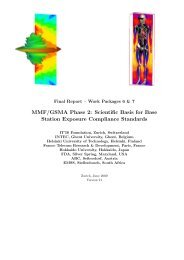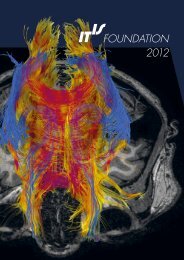Projects
download report
download report
- No tags were found...
Create successful ePaper yourself
Turn your PDF publications into a flip-book with our unique Google optimized e-Paper software.
Overview <br />
Introduction<br />
Ever since the beginning of 1993, when the use of<br />
portable cellular phones became an issue of public health<br />
concern, exposure and health risk assessment has<br />
become one of the main focuses of our activities. We<br />
have always committed ourselves to using the highest<br />
standards of scientific rigor to determine the maximum<br />
exposure and health risk, applying the most advanced<br />
and sensitive techniques. This approach has not always<br />
been received with much enthusiasm from all quarters.<br />
However, most of industry by now also realizes that<br />
longterm public con·fidence in wireless technology is a<br />
delicate thing that can only be kept alive by objective<br />
research done by completely independent organizations<br />
of repute. We commend the farsightedness of those<br />
companies which stood by this concept right "from the<br />
outset.<br />
Progress in Exposure Assessment<br />
Near Field Scanners<br />
By the end of 1994 the development of the first near<br />
field scanner enabling accurate dosimetric and near-field<br />
evaluations had been largely completed. Growing interest<br />
in this product led to the grounding of the spin-off company<br />
Schmid & Partner Engineering AG (SPEAG), which<br />
quickly turned the prototype DASY1 into the commercial<br />
product DASY2. The company, whose activities are<br />
briefly described in this report, is currently focusing their<br />
efforts on the development of DASY3, which is scheduled<br />
to be launched in mid 1997.<br />
Phantoms for Compliance Testing<br />
Since little data on the dependence of absorption on<br />
anatomic features was availiable, it was not possible to<br />
define or establish up-front which phantom would be<br />
suitable for compliance testing. It was also clear from the<br />
beginning that the exposure assessed with any given<br />
phantom should not underestimate the maximum exposure<br />
occurring within a reasonable cross-section of the<br />
mobile phone user population, including children. The<br />
implications of this problem have been intensively<br />
studied during the last two years, resulting in several<br />
publications on topics including: 1) the dependence of<br />
EM energy absorption at 900 and 1800 MHz, 2) the<br />
effect of external metallic accessories and 3) metallic<br />
implants, and 4) the differences in the absorption<br />
between children and adults. A generic phantom was<br />
developed based on the findings of these studies, and<br />
data from a detailed anatomical study of the area around<br />
the ear. Compliance testing of cellular phones performed<br />
with this phantom guarantee that the exposure of at<br />
least 90% of actual users will not be underestimated.<br />
Data on the shape of the phantom is now publicly available,<br />
and SPEAG has integrated this phantom as well as<br />
a very precise phone positioner into its product line.<br />
Calibration Procedures<br />
The package consisting of the scanner, phantom and the<br />
refined calibration procedure, developed in 1995, is an<br />
ideal and accurate dosimetric evaluation system for<br />
testing compliance with any safety standard defined in<br />
terms of the specific absorption rate (SAR). Further<br />
improvements are still needed in the area of error analysis<br />
and traceability of the calibration. Ongoing research<br />
projects are currently tackling these areas.<br />
Dosimetric Evaluation<br />
In 1996 the group performed several dosimetric evaluations<br />
of commercial cellular phones or prototypes for<br />
companies in Europe and Japan.<br />
Near Field Evaluation<br />
Near-Field Scanner<br />
Our experience has clearly demonstrated the meaningfulness<br />
of accurate near-field evaluations in free space.<br />
DASY3 will provide further functionality for such<br />
evaluations.<br />
Electric and Magnetic Near-Field Probes<br />
Together with our industrial partners and ·funding from<br />
KTI, the fourth generation of isotropic E- and H-field<br />
probes are currently being developed. These will outperform<br />
the best E-field probes currently commercially<br />
available from SPEAG in terms of spatial resolution,<br />
·frequency range and isotropy. Probes optimized for<br />
special media will become commercially available before<br />
autumn 1997.<br />
Computational Techniques<br />
EMSIM Platform<br />
During the past year the group has found the way back<br />
to its roots in electromagnetic computations. Under the<br />
auspices of the Swiss priority program" Micro & Nano<br />
System Technology (MINAST)" the development and<br />
implementation of the electromagnetic simulation<br />
7





